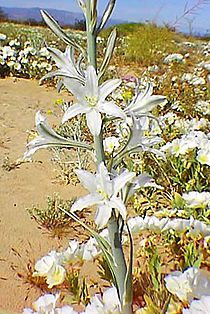Hesperocallis facts for kids
Quick facts for kids Hesperocallis |
|
|---|---|
 |
|
| Scientific classification | |
| Kingdom: | |
| Order: | |
| Family: |
Agavaceae
|
| Genus: |
Hesperocallis
A.Gray, 1868
|
| Species: |
H. undulata
|
| Binomial name | |
| Hesperocallis undulata A.Gray, 1868
|
|
The Hesperocallis is a special group of flowering plants. It has only one type of plant in it, called Hesperocallis undulata. Most people know it as the desert lily. You can find this beautiful plant growing in the hot, dry desert areas of the southwest of North America.
Contents
What is the Desert Lily?
The desert lily is a unique plant that stands out in its dry home. It's known for its wavy leaves and pretty flowers. This plant has adapted well to living in places with very little water. It's a true survivor of the desert!
How Scientists Classify the Desert Lily
For a long time, scientists weren't sure exactly where the desert lily fit in the plant family tree. At first, many thought it belonged to the Liliaceae family, which includes true lilies. But its relationships were a bit of a mystery.
Other ideas placed it in different families, like Hemerocallidaceae or Funkiaceae. In 1972, a scientist named Hamilton Traub even created a brand new family just for the desert lily, called Hesperocallidaceae.
More recently, with new ways to study plants, scientists have learned more. The APG II system now puts the desert lily in the Asparagaceae family. This family also includes plants like asparagus and agave. It's part of a larger group called monocots.
Desert Lily's Close Relatives
New studies using genetics have shown that the desert lily is very closely related to the Agave plant. Because of this strong connection, many experts now agree that the desert lily should be placed in the Agavaceae family. This helps us understand its place in the plant world much better.
Images for kids
-
The BLM Desert Lily Preserve, a special place where these lilies are protected near Desert Center, California.
See also
 In Spanish: Hesperocallis undulata para niños
In Spanish: Hesperocallis undulata para niños


